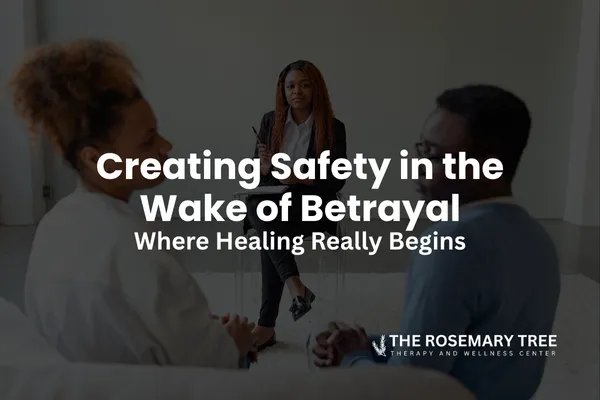
Creating Safety in the Wake of Betrayal: Where Healing Really Begins
When Everything Feels Unsafe
After betrayal or broken trust, everything changes. The way your partner looks at you, the sound of a text notification, the quiet between conversations. What once felt familiar now feels uncertain.
Many couples try to rush back into connection, but safety must come first. You cannot rebuild intimacy or forgiveness in an environment where either person feels emotionally or physically unsafe. Safety is not the absence of conflict; it is the presence of stability, honesty, and calm.
This is where healing truly begins.
Why Safety Matters More Than Connection at First
When betrayal happens, the body experiences it as trauma. The nervous system goes into protection mode, scanning for danger even when things seem calm. For the betrayed partner, this may look like hypervigilance, checking phones, or needing reassurance. For the partner who caused harm, it might show up as withdrawal, guilt, or defensiveness.
Both are trying to feel safe, just in different ways.
Rebuilding safety means learning to slow down, communicate honestly, and bring predictability back into the relationship. Before there can be closeness, there must be calm. Before there can be forgiveness, there must be truth.
What Emotional Safety Looks Like
Emotional safety is not about avoiding pain or pretending everything is fine. It’s about knowing that honesty will not be met with attack, and that expressing emotion will not lead to punishment or rejection.
In a recovering relationship, emotional safety looks like:
Consistent honesty and transparency
Clear boundaries that are respected
Listening without interruption or defense
A shared commitment to accountability
Calmness after conflict instead of avoidance
These small moments of steadiness become the stepping stones toward trust.
How Physical Safety Connects to Emotional Healing
When emotions are high, the body responds. Tension builds in the chest, breathing becomes shallow, and muscles tighten. This is the body’s way of saying, “I’m not safe right now.”
Physical safety means learning to calm the body before engaging in hard conversations. It can be as simple as:
Taking a pause to breathe before speaking
Sitting where both partners feel comfortable and not cornered
Agreeing on timeouts during overwhelming discussions
Creating a calm environment before diving into emotional work
The body cannot heal in chaos. When the body feels safe, the heart begins to follow.
Why Weekly Therapy Isn’t Always Enough
Weekly therapy can be helpful, but for couples in crisis, one hour often isn’t enough to create safety or stability. The moment one partner begins to open up, time runs out, and both leave feeling unfinished and frustrated.
That’s why we offer Accelerated Deep-Work Therapy Intensives, designed specifically for couples who need to rebuild safety before they can rebuild connection.
During an intensive, couples have the time and space to:
Slow down and truly understand what happened
Learn how trauma affects the nervous system and emotions
Reconnect through guided dialogue and grounding tools
Create a shared roadmap for safety and recovery
This format gives both partners the space to be heard, understood, and supported without rushing.
How Safety Begins to Take Shape
At first, rebuilding safety might not look like progress. It might mean taking breaks from heavy topics, setting communication boundaries, or focusing on self-regulation. But as safety grows, tension begins to ease.
You might notice:
Arguments that once escalated now end calmly
Truth shared without fear of explosion
Comfort returning to shared spaces
The ability to sit together quietly without anxiety
These are not small things. They are signs that healing has started.
When You’re Both Scared but Still Here
Most couples who reach this point are exhausted. The betrayed partner feels like safety is gone forever, and the partner who caused harm worries they’ll never be trusted again. But the fact that you are still here, reading this, means you haven’t given up.
Creating safety is slow work, but it’s possible. It doesn’t mean forgetting or excusing the past—it means building a foundation strong enough to hold both truth and hope at the same time.
Final Thoughts
If your relationship feels fragile but you’re both ready to understand what safety could look like again, we would love to help. Our therapy intensives are an in-person experience designed to help couples slow down, find stability, and begin again with honesty and care.
You can reach out to us here, and we’ll connect with you to talk through what this process could look like for you. There’s no pressure, just a conversation about whether this is the right next step.
